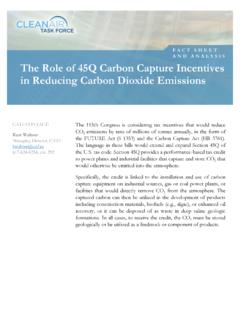Transcription of Assessment of the major hazard potential of carbon dioxide
1 Health and Safety Executive Page 1 of 28 Assessment of the major hazard potential of carbon dioxide (CO2)A paper by: Dr Peter Harper, Health and Safety Executive (HSE)Advisers: Ms Jill Wilday (HSL) and Mr Mike Bilio (OSD)IntroductionCarbon dioxide (CO2) is a substance which has many domestic and commercial uses and over the years standards and legislative controls have been built up to maintain an acceptable level of risk for those who could be harmed by it. HSE has long established its approach for evaluating hazards from dangerous substances that involves an estimation of the consequences of exposure to a level of harmful agent and the time of exposure needed to give an accumulation to cause advent of carbon capture and storage (CCS) will result in CO2 being handled in quantities many orders of magnitude greater than it is today.
2 For example, a coal-fired power station consuming 8000 te a day of coal (in the region of one GW power generation) will produce up to 30 000 te/day of CO2 to be captured and transported to long-term storage facilities. Whereas in existing CO2 handling facilities an inadvertent release of CO2 may have created a small-scale hazard , potentially only affecting those in the local vicinity, a very large release of CO2 from a CCS scale of operation has the potential to produce a harmful effect over a significantly greater area and as such it would be likely to affect a significant number of people. CCS scale of CO2 operation, therefore, has the potential to introduce a major accident hazard (MAH) where currently one does not exist. This paper sets out an initial Assessment of the hazards resulting from loss of containment incidents from vessels containing large quantities of CO2 and discusses the subsequent major hazard potential associated with such is viewed globally as a key carbon abatement technology as it will enable the capture of millions of tonnes of CO2 from significant CO2 emitters (eg power stations) and then for the CO2 to be transported in pipelines or ships before being injected deep into the earth s rock formations where it will remain trapped.
3 Within the EU there are plans for 10-12 demonstration projects to be built by 2015 and recommendations for a further 80-120 plants to be on line by the scale of CCS projects and the need to handle very large quantities of CO2, for economic and technical reasons the captured vapour phase CO2 may be compressed at high pressures into its liquid (<31 C) or supercritical phase ( 31 C) Health and Safety Executive Page 2 of 28 Assessment of the major hazard potential of carbon dioxide (CO2)in some circumstances. The CO2 may also be temporarily stored at lower pressures in refrigerated or semi-refrigerated vessels for intermediate storage prior to transfer to the known impact from receiving a harmful dose of CO2 with what could be very large hazard zones due to the release of very large inventories of CO2 (particularly if it exists in the liquid or supercritical phase), creates the potential for CO2 to be a major accident hazard (MAH).
4 The likelihood of a CO2 MAH occurrence should be very low due to the risk management measures, however, to ensure this in this case, appropriate risk management standards and regulation need to be put in place. BackgroundDangers of CO2CO2 has been recognised as a significant workplace hazard for over 100 years. Noteworthy properties of CO2 are:at standard temperature and pressure it has a low viscosity and a density of around times that of air ( kg/m3);at atmospheric pressure and a temperature of C it changes directly from a solid phase to a gaseous phase through sublimation, or from gaseous to solid through deposition;a supercritical fluid exists above a substance s critical temperature and pressure ( C and bar for CO2), above which supercritical CO2 exhibits the density of a liquid and viscosity of a gas;a dense phase fluid is a collective term generally used to describe both a liquid and supercritical fluid.
5 AndCO 2 has been shown to exhibit a level of toxicity related to the concentration and time of , 2 CO2 is commonly thought of as posing a threat to life through asphyxiation when it displaces the oxygen in air down to dangerously low levels. For CO2 to reduce the oxygen concentration in air down to a level that is immediately dangerous to life, the CO2 concentration would need to be in the order of 50% v/v. Evidence shows, however, that CO2 does create an immediate threat to life at a concentration of only 15% in air due to the toxicological impact it has on the body when inhaled at this concentration. In humans, CO2 is a normal component of blood gases at low concentrations, however, at high exposure inhalation levels it is lethal. In humans one of the most powerful stimuli known to affect the respiration is CO2 and this results in humans being very sensitive to changes in CO2 concentrations.
6 The inhalation of elevated concentrations of CO2 can increase the acidity of the blood triggering adverse effects on the respiratory, cardiovascular and central nervous systems. Depending on the CO2 concentration inhaled and exposure duration, toxicological symptoms in humans range from headaches (in the order of 3% for 1 hour), increased respiratory and heart rate, dizziness, muscle twitching, confusion, unconsciousness, coma and death (in the order of >15% for 1 minute).At CO2 concentrations in excess of 50% in air whether a person dies due to the toxicological effect of CO2 inhalation or due to oxygen depletion is not clear and arguably immaterial. In both cases death would be the and Safety Executive Page 3 of 28 Assessment of the major hazard potential of carbon dioxide (CO2)To assess the toxicity of substances HSE has developed what is known as an Assessment of Dangerous Toxic Load (DTL) to calculate the exposure conditions in terms of concentration and duration of exposure.
7 In this Assessment the specified level of toxicity (SLOT) and the significant likelihood of death (SLOD) are defined. For land use planning the HSE has defined the SLOT as causing: severe distress to almost everyone in the area; substantial fraction of exposed population requiring medical attention; some people seriously injured, requiring prolonged treatment; highly susceptible people possibly being killed, likely to cause 1-5% lethality rate from a single exposure to a certain concentration over a known amount of time. SLOD is defined as causing 50% lethality from a single exposure over a known amount of time. Data for this calculation is collected from routine toxicity testing on animals, using cautious results. More detailed background information on the SLOT and SLOD calculations can be found on the HSE website ( ).
8 Table 1 presents the output of the HSE s Dangerous Toxic Load Assessment for CO2. The table illustrates a significant danger to humans if they inhale CO2 at concentrations above around 7% in air (ie > 70 000 ppm). It also highlights, the effect of that toxicity increasing rapidly for only small changes in concentration above a certain level (ie there is not a large difference between the SLOD and SLOT values).2 Differences in CO2 concentration between different lethality levels and exposure times are relatively small; concentrations for lethality levels 1-5% and 50% for a given exposure time differ by only 33%. Although CO2 is only mildly toxic to humans when compared with hydrogen sulphide, for example, above concentrations of about 7% in air, humans are particularly sensitive to further 1: Concentration vs time consequences for CO2 inhalationInhalation exposure timeSLOT: 1-5% FatalitiesSLOD: 50% FatalitiesCO2 Concentration in air*CO2 Concentration in air*%ppm%ppm60 000 000 ppm30 000 000 ppm20 000 000 ppm10 000 000 ppm5 000 000 ppm1 000 ppm14%140 000 ppmNote: * Concentration by volumeIn addition to the hazard posed by CO2 if inhaled, there are additional hazards associated with dense phase CO2 that are likely to occur when CO2 is handled in large quantities and at high pressure.
9 These can arise when a release occurs and the pressure suddenly falls or is lost completely. These hazards include cryogenic burns, embrittlement of pipe work, toxic contamination and possibly grit blasting of neighbouring plant (although information suggests that CO2 snow also needs to be compressed in order to give a grit blasting effect).Health and Safety Executive Page 4 of 28 Assessment of the major hazard potential of carbon dioxide (CO2)CO2 inhalation incidentsThere are a number of natural and industrial releases of CO2 that have recorded injuries and death due to CO2 inhalation. Here are details of some CO2 incidents that highlight the potential dangers when a significant quantity of CO2 is released and inhaled by people. Fire suppression systemsCO2 (followed by nitrogen) is the most commonly used inert gas extinguishing agent.
10 A comprehensive review of CO2 incidents related to use in fire protection was undertaken by the US Environmental Protection Agency (EPA),3 which reviewed governmental, military, public, and private document archives. From 1975 to 2000, a total of 51 incident records were located that reported a total of 72 deaths and 145 injuries resulting from accidents involving the discharge of CO2 from fire extinguishing systems. The review indicates that the majority of reported incidents occurred during maintenance on or around the CO2 fire protection system nchengladbachApproximately 15 tonnes of CO2 was accidentally released from a fire extinguishing installation in M nchengladbach, Germany (2008).4 Due to coincidental failure of door seals, the released CO2 was not contained by the building and it spread outside where there were very still air conditions.
















